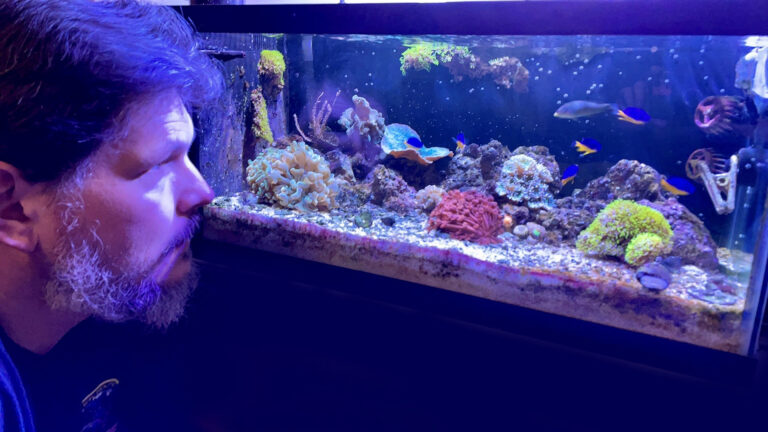From Concept to Reality: How Professional Fish Tank Designers Create Stunning Underwater Worlds
Dive into the mesmerizing world of professional fish tank designers as they transform ordinary aquariums into extraordinary underwater masterpieces. These creative geniuses possess a unique blend of artistic vision, technical expertise, and a deep understanding of aquatic ecosystems. From concept to reality, they meticulously craft stunning environments that not only showcase the vibrant colors and graceful movements of the aquatic life within but also evoke a sense of wonder and tranquility for the observer. Drawing inspiration from nature’s beauty, these designers carefully select the perfect combination of plants, rocks, and ornaments to create a harmonious balance that mimics the natural habitats of the fish and enhances their well-being. With their expertise in tank size, water quality, and lighting, these professionals ensure that every element is optimized for the health and happiness of the aquatic inhabitants. Join us as we dive into the captivating world of professional fish tank design, where imagination knows no bounds, and underwater worlds come to life.

The Role of Professional Fish Tank Designers
Professional fish tank designers play a vital role in creating stunning underwater worlds. They are the artists and architects who bring imagination to life, turning a simple fish tank into a captivating masterpiece. These designers possess a unique set of skills that combine artistry, technical knowledge, and a deep understanding of aquatic ecosystems. They have an eye for detail and a keen sense of aesthetics, ensuring that every element in the tank is carefully chosen to create a harmonious and visually appealing environment.
One of the primary roles of professional fish tank designers is to create an environment that is not only visually stunning but also conducive to the health and well-being of the aquatic inhabitants. They carefully consider factors such as tank size, water quality, and lighting to ensure that the fish thrive in their new habitat. By understanding the specific needs of different fish species, these designers can create a tank that mimics their natural habitat, providing them with the ideal living conditions to flourish.
In addition to creating visually appealing environments, professional fish tank designers also play a crucial role in educating and inspiring aquarium enthusiasts. They often collaborate with aquarium owners to design tanks that reflect their personality and preferences while maintaining the well-being of the fish. Through their expertise and passion for their craft, these designers help aquarium owners appreciate the beauty and complexity of aquatic ecosystems, fostering a greater understanding and respect for the underwater world.
Understanding the Concept of Fish Tank Design
Before diving into the creation of a stunning underwater world, professional fish tank designers must first understand the concept of fish tank design. It involves a careful balance between aesthetics and functionality, ensuring that the tank not only looks beautiful but also provides a safe and healthy environment for the fish.
A crucial aspect of fish tank design is the consideration of the fish species that will inhabit the tank. Different fish have varying requirements in terms of space, water parameters, and tank mates. Designers must research and understand the specific needs of each species to create a tank that caters to their unique requirements. This involves studying their natural habitats, behavior patterns, and compatibility with other fish.
Another important aspect of fish tank design is the consideration of the tank’s size and shape. Larger tanks generally provide a more stable environment for the fish, as they offer greater water volume and surface area for gas exchange. The shape of the tank can also impact the flow of water and the overall aesthetic appeal. Designers must carefully consider these factors when selecting the appropriate tank for a specific project.
Factors to Consider in Fish Tank Design
Creating a visually stunning and functional fish tank involves considering several key factors. These factors include tank size, water quality, lighting, filtration, and the selection of appropriate plants and decorations. Each element plays a crucial role in ensuring the health and well-being of the aquatic inhabitants and creating an aesthetically pleasing environment.
Tank size is an essential factor in fish tank design, as it determines the available space for the fish and the overall stability of the aquatic ecosystem. A larger tank provides more swimming space for the fish and allows for a more diverse selection of species. It also offers better water quality and stability, as there is a larger volume of water to dilute waste products and maintain stable water parameters.
Water quality is another critical factor to consider in fish tank design. It includes parameters such as temperature, pH level, ammonia, nitrite, and nitrate levels. These parameters must be carefully monitored and maintained within the optimal range for the specific fish species. Professional fish tank designers have a deep understanding of water chemistry and use advanced filtration systems to ensure excellent water quality.
Lighting is an essential element in fish tank design, as it not only enhances the visual appeal of the aquarium but also provides the necessary light energy for the growth of plants and the well-being of the fish. Designers must select the appropriate lighting system that mimics the natural light conditions of the fish’s natural habitat. This involves considering factors such as light intensity, spectrum, and photoperiod.
Filtration is vital for maintaining a healthy and balanced aquatic environment. It helps remove waste products, excess nutrients, and harmful substances from the water, ensuring optimal water quality for the fish. Professional fish tank designers carefully select the appropriate filtration system based on the tank’s size, fish species, and desired water parameters.
The selection of appropriate plants and decorations is another crucial factor in fish tank design. Live plants not only enhance the visual appeal of the tank but also provide natural filtration, oxygenation, and hiding places for the fish. Decorations such as rocks, driftwood, and caves create a natural and stimulating environment for the fish, mimicking their natural habitats. Designers carefully select these elements to create a harmonious and visually appealing underwater world.
Researching and Gathering Inspiration for Fish Tank Designs
Creating a stunning fish tank design requires research and inspiration. Professional fish tank designers immerse themselves in the world of aquatic ecosystems, studying the natural habitats of fish species and exploring various design styles and techniques. They draw inspiration from nature’s beauty, underwater landscapes, and artistic concepts to create unique and captivating designs.
Researching the natural habitats of fish species is essential for understanding their specific needs and preferences. Designers study the environmental conditions, water parameters, and the interactions between different species in their natural habitats. This knowledge helps them recreate similar conditions in the fish tank, ensuring the well-being and compatibility of the fish.
In addition to studying natural habitats, fish tank designers also explore various design styles and techniques to gather inspiration for their projects. They analyze the work of other designers, visit aquariums, and participate in industry events and exhibitions to stay updated with the latest trends and innovations in fish tank design. By staying informed and inspired, these designers can push the boundaries of creativity and create truly exceptional underwater worlds.
Creating a design plan and sketching the layout
Once the research and inspiration-gathering phase is complete, professional fish tank designers move on to creating a design plan and sketching the layout of the tank. This involves translating their ideas and concepts into a tangible blueprint that guides the construction and setup of the tank.
The design plan includes details such as the selection of fish species, the arrangement of plants and decorations, and the positioning of equipment and lighting fixtures. Designers carefully consider the compatibility of different fish species, their preferred swimming areas, and their interactions with plants and decorations.
Sketching the layout allows designers to visualize the tank’s final appearance and make any necessary adjustments before starting the construction process. This step helps ensure that the design is balanced and visually appealing, taking into account factors such as color, texture, and proportion.
Professional fish tank designers often use specialized software or hand-drawn sketches to create the layout. They consider elements such as the focal point of the tank, the placement of plants and decorations, and the overall flow of the design. By creating a detailed and well-thought-out layout, designers can bring their vision to life in a precise and organized manner.
Selecting the Right Materials and Equipment for the Fish Tank
Selecting the right materials and equipment is crucial for the success of any fish tank design project. Professional fish tank designers carefully consider factors such as durability, aesthetics, and functionality when choosing these elements.
The selection of materials for the tank itself is essential to ensure its structural integrity and longevity. Different materials, such as glass and acrylic, offer varying benefits and considerations. Glass tanks provide excellent clarity and scratch resistance, while acrylic tanks are lighter and more impact-resistant. Designers must assess the specific requirements of each project and select the appropriate material accordingly.
In addition to the tank material, designers also consider the selection of equipment such as filtration systems, heaters, and lighting fixtures. These components must be chosen based on the specific needs of the fish species and the desired water parameters. Professional fish tank designers have in-depth knowledge of the various types of equipment available in the market and select the most suitable options for each project.
The selection of plants and decorations is another crucial aspect of fish tank design. Designers carefully choose plants that are compatible with the fish species and create a natural and visually appealing environment. They also consider factors such as the growth rate, light requirements, and maintenance needs of different plant species. When selecting decorations, designers ensure that they are safe for the fish and complement the overall design concept.
By selecting the right materials and equipment, professional fish tank designers lay the foundation for a successful and visually stunning underwater world.
Setting up the Fish Tank and Ensuring Proper Water Conditions
Once the design plan is finalized, professional fish tank designers proceed with setting up the fish tank and ensuring proper water conditions. This step involves carefully following a series of procedures to create an environment that is conducive to the health and well-being of the fish.
The first step in the fish tank setup is to thoroughly clean and rinse all materials, including the tank, gravel, decorations, and equipment. This helps remove any dust, debris, or chemicals that may be present, ensuring a clean and safe environment for the fish.
Next, designers add the appropriate substrate, such as gravel or sand, to the tank. The choice of substrate depends on the design concept and the specific requirements of the fish species. Some fish prefer a sandy bottom, while others thrive in a gravel substrate. Designers carefully consider the needs of the fish and the desired aesthetic appeal when selecting the substrate.
Once the substrate is in place, designers carefully fill the tank with water. It is essential to use dechlorinated water to prevent any harm to the fish. Designers also ensure that the water temperature and pH level are within the optimal range for the specific fish species. They may need to adjust these parameters using heaters or water conditioners to create the ideal environment for the fish.
After filling the tank with water, professional fish tank designers install the necessary equipment, such as filtration systems, heaters, and lighting fixtures. These components ensure the proper functioning of the tank and maintain optimal water quality and conditions for the fish.
Designers carefully monitor the water parameters and make any necessary adjustments to ensure that the tank is stable and conducive to the health and well-being of the fish. This involves regular aquarium testing of parameters such as temperature, pH level, ammonia, nitrite, and nitrate levels. If any parameters are outside the optimal range, designers take appropriate measures to correct them.
Setting up the fish tank and ensuring proper water conditions is a crucial step in the fish tank design process. Professional designers pay close attention to every detail to create an environment that is both visually stunning and conducive to the health and happiness of the aquatic inhabitants.
Adding Decorative Elements and Creating a Captivating Underwater World
With the fish tank set up and the water conditions optimized, professional fish tank designers move on to the next phase: adding decorative elements and creating a captivating underwater world. This is where the design concept comes to life, and the tank transforms into a stunning masterpiece.
Designers carefully select and arrange plants, rocks, driftwood, and decorations to create a visually appealing and natural-looking environment. They consider factors such as color, texture, and proportion to create a harmonious balance that mimics the fish’s natural habitats. By strategically placing these elements, designers create hiding places, resting areas, and territories for the fish, enhancing their well-being and overall tank aesthetics.
The selection of plants plays a crucial role in creating a captivating underwater world. Designers choose plants based on their compatibility with the fish species, growth rate, and desired aesthetic appeal. They consider factors such as leaf shape, color, and texture to create a visually striking and diverse underwater landscape. Live plants not only enhance the visual appeal but also contribute to the overall health of the tank by providing natural filtration and oxygenation.
Rocks, driftwood, and other decorations are carefully selected to complement the plant selection and create a natural and stimulating environment. Designers consider the size, shape, and texture of these elements to mimic the natural habitats of the fish. By strategically placing rocks and driftwood, designers can create caves, crevices, and hiding places for the fish, allowing them to exhibit natural behaviors and feel secure in their new home.
Professional fish tank designers also pay close attention to the overall flow and focal points of the tank. They carefully arrange the plants and decorations to guide the viewer’s gaze and create a visually pleasing composition. By considering elements such as height, placement, and color contrast, designers create a captivating underwater world that draws the observer into its mesmerizing beauty.
Maintenance and Care for Professionally Designed Fish Tanks
Creating a stunning underwater world is just the beginning. To ensure the longevity and health of the fish tank, professional fish tank designers educate aquarium owners on maintenance and care. They provide guidelines on water testing, regular cleaning, and proper feeding to maintain optimal water quality and the well-being of the fish.
Regular aquarium testing is essential to monitor parameters such as temperature, pH level, ammonia, nitrite, and nitrate levels. Designers educate aquarium owners on the importance of regular testing and provide guidance on how to interpret the results. If any parameters are outside the optimal range, designers recommend appropriate measures to correct them, such as water changes or adjustments to the filtration system.
Regular cleaning is another crucial aspect of fish tank maintenance. Designers educate aquarium owners on the importance of removing debris, uneaten food, and waste products from the tank. They provide guidelines on how to perform water changes and clean the substrate, decorations, and equipment. By following these maintenance practices, aquarium owners can ensure a clean and healthy environment for the fish.
Feeding the fish is another vital aspect of fish tank care. Designers educate aquarium owners on the specific dietary requirements of the fish species and provide guidelines on proper feeding practices. They emphasize the importance of a balanced diet and portion control to prevent overfeeding and maintain the health and well-being of the fish.
Professional fish tank designers also recommend regular observation and interaction with the fish.
If you're in the Murfreesboro Area

Please stop by Animal City on NW Broad St. They have high quality fish and their staff is more than helpful!
If you're in the Nashville Area

Visit Aquatic Critter on Nolensville Road. Huge selection of fish and equipment, and their staff is very knowgledable!



